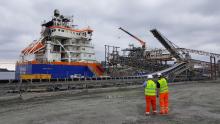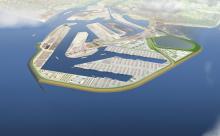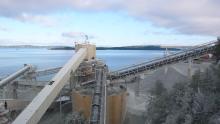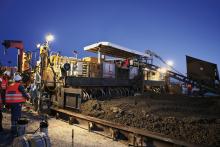Yeoman Halsvik, a Norwegian subsidiary of construction materials supplier heavyweight
The German submarine U-864 was sunk by the British in 1945 while heading to Japan to transport war load – including a large quantity of mercury. Due to the torpedo attack, the U-864 was divided into sections and sunk to a depth of 145m-160m.
The shipwreck was located by the Royal Norwegian Navy in March 2003 off the west coast of Norway near the island of Fedje, at the top of a steep slope in the seabed. Here, it was discovered that the mercury had been seeping out of rusted containers and contaminating the region and sea life.
The Norwegian government has since extensively assessed the best possible solution to try and stabilise the wreck and contain the toxic mercury. It was recommended that ‘entombing’ the wreckage under a layer of sand and gravel would be the safest possible option for stabilisation. At the end of 2015, the Norwegian Coastal Administration awarded the contract to Van Oord to carry out the works.
Subsequently, Van Oord enlisted the expertise of Yeoman Halsvik to provide a specialist material that would exceptionally perform the job of sealing off the existing seabed, and as such, prevent the future release of mercury.
Yeoman Halsvik supplied a specialised sand to comply with Van Oord’s requirement, as well as Sub base, and Offshore material from its quarry based at the Port of Slovag, on the West coast of Norway. With the threat of oversize or contamination of the material with the larger stones, Van Oord implemented a thorough quality control procedure to monitor the spreading, and to ensure that there would be no risk of any potential seabed contamination during the installation process.
At a working depth of 150 metres, Van Oord built a foundation (counter fill) of more than 35,000 tonnes of specialist sand and 160,000 tonnes of stone, in order to guarantee the stability of the seabed slope and ensure that the surrounding sediments would not slide off the slope.
Preventing the spread of mercury to the environment was the main objective during the installation of the counter fill’, with stringent requirements set for environmental monitoring of the work. Van Oord developed a special installation method for the placement of the sand, in order to minimise the disturbance of the seabed. As the exact volumes were not known and the installation time was relatively short, Yeoman Halsvik needed to ensure good production capacity and quick loading of the vessels, which was successfully achieved.










